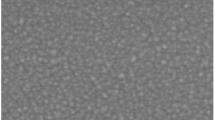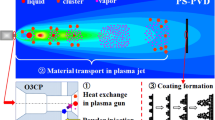Abstract
The present work is regarding the study of double zone thermal chemical vapor deposition (CVD) and plasma enhanced chemical vapor deposition (PECVD) systems. Here, we have tried to describe the principle, working and technical details as well as the advantages and disadvantages associated with the abovementioned systems. Both the deposition variants, i.e., double zone thermal CVD and PECVD, offer a wide range of advantages like the uniformity of thin films along with easy accessibility over a wide range of precursors for nanomaterial synthesis. It is also concluded that the former system has an edge over other existing conventional deposition techniques as we can control the migration of the source particles, whereas PECVD offers the advantage of performing the deposition of thin films over comparatively low temperature which allows the usage of the substrate having a low melting point.
Shreya and Anukool Yadav—These authors have contributed equally
Access this chapter
Tax calculation will be finalised at checkout
Purchases are for personal use only
Similar content being viewed by others
References
Grimmeiss HG (1999) Silicon-germanium-a promise into the future? Semiconductors 33:939–941
Wieder AW, Neppl F (1992) Cmos technology trends and economics. IEEE Micro 12(4):10–19. https://doi.org/10.1109/40.149732
Jones AC, Hitchman ML (2009) Chemical vapour deposition—precursors, processes and applications. Royal Soceity of Chemistry, Cambridge
Riordan M (2007) From bell labs to silicon valley: a saga of semiconductor technology transfer, 1955–61. Electrochem Soc Interface 16(3):36–41. https://doi.org/10.1149/2.f04073if
Schlesinger M (2004) Electroplating. In: Kirk-Othmer encyclopedia of chemical technology. Wiley, Hoboken, NJ, USA
Hall DB, Underhill P, Torkelson JM (1998) Spin coating of thin and ultrathin polymer films. Polym Eng Sci 38(12):2039–2045. https://doi.org/10.1002/pen.10373
Safarian J, Engh TA, Vacuum evaporation of pure metals. https://doi.org/10.1007/s11661-012-1464-2
184 VE, Er NB, Targets P, Sigmundt P (1969) Physical reviews theory of sputtering. I. Sputtering Yield of Amorphous and
Powell CF, Oxley JH, Blocher JM (1966) Vapour deposition. The Electrochemical Society, Pennington NJ
Haubner R (2013) The history of hard CVD coatings for tool applications at the University of Technology Vienna. Int J Refract Metal Hard Mater 41:22–34. https://doi.org/10.1016/j.ijrmhm.2013.01.012
Morosanu CE (1990) Thin films by chemical vapour deposition, vol 7, 1st edn. Elsevier Science, New York
Kim MJ et al (2020) Large-Area, conformal, and uniform synthesis of hybrid polymeric film via initiated chemical vapor deposition. Macromol Mater Eng 2000608. https://doi.org/10.1002/mame.202000608
Alf ME et al (2010) Chemical vapor deposition of conformal, functional, and responsive polymer films. Adv Mater 22(18):1993–2027. https://doi.org/10.1002/adma.200902765
Abelson JR, Girolami GS (2020) New strategies for conformal, superconformal, and ultrasmooth films by low temperature chemical vapor deposition. J Vac Sci Technol A 38(3):030802. https://doi.org/10.1116/6.0000035https://doi.org/10.1116/6.0000035
Kamalakar MV, Groenveld C, Dankert A, Dash SP (2015) Long distance spin communication in chemical vapour deposited graphene. Nat Commun 6(1):6766. https://doi.org/10.1038/ncomms7766
Chen K, Shi L, Zhang Y, and Z. Liu, (2018) Scalable chemical-vapour-deposition growth of three-dimensional graphene materials towards energy-related applications. Chem Soc Rev 47(9):3018–3036. https://doi.org/10.1039/c7cs00852j
Perrin J, Schmitt J, Hollenstein C, Howling A, Sansonnens L (2000) Physics of plasma-enhanced chemical vapour deposition for large-area coating: industrial application to flat panel displays and solar cells. Plasma Phys Control Fusion 42(12 SUPPL. B). https://doi.org/10.1088/0741-3335/42/12B/326
Cheon J, Gozum JE, Girolami GS (1997) Chemical vapor deposition of MoS2 and TiS2 films from the metal-organic precursors Mo(S-t-Bu)4 and Ti(S-t-Bu)4. Chem Mater 9(8):1847–1853. https://doi.org/10.1021/cm970138p
Brossard JM, Hierro MP, Sánchez L, Bolívar FJ, Pérez FJ (2006) Thermodynamical analysis of Al and Si halide gaseous precursors in CVD. Review and approximation for deposition at moderate temperature in FBR-CVD process. Surf Coatings Technol 201(6):2475–2483. https://doi.org/10.1016/j.surfcoat.2006.04.018
Gordon PG, Kurek A, Barry ST (2015) Trends in copper precursor development for CVD and ALD applications. ECS J Solid State Sci Technol 4(1):N3188–N3197. https://doi.org/10.1149/2.0261501jss
Hess DW et al (1991) Advances in chemistry 221. Am Chem Soc. Accessed 07 Mar 2021 (Online). Available: https://pubs.acs.org/sharingguidelines
Kafizas A, Carmalt CJ, Parkin IP (2013) CVD and precursor chemistry of transition metal nitrides. Coord Chem Rev 257(13–14):2073–2119. https://doi.org/10.1016/j.ccr.2012.12.004
Hellegouarc’h F, Arefi-Khonsari F, Planade R, Amouroux J (2001) PECVD prepared SnO2 thin films for ethanol sensors. Sens Actuators B Chem 73(1):27–34. https://doi.org/10.1016/S0925-4005(00)00603-1
Crowell JE (2003) Chemical methods of thin film deposition: chemical vapor deposition, atomic layer deposition, and related technologies. J Vac Sci Technol A Vacuum Surfaces Film 21(5):S88–S95. https://doi.org/10.1116/1.1600451
Mathur S, Kuhn P (2006) CVD of titanium oxide coatings: comparative evaluation of thermal and plasma assisted processes. Surf Coatings Technol 201(3–4):807–814.https://doi.org/10.1016/j.surfcoat.2005.12.039
Dorval Dion CA, Tavares JR (2013) Photo-initiated chemical vapor deposition as a scalable particle functionalization technology (a practical review). Powder Technol 239:484–491. https://doi.org/10.1016/j.powtec.2013.02.024
Choy KL (2003) Chemical vapour deposition of coatings. Progress Mater Sci 48(2):57–170. https://doi.org/10.1016/S0079-6425(01)00009-3
Vahlas C, Caussat B, Serp P, Angelopoulos GN (2006) Principles and applications of CVD powder technology. Mater Sci Eng R: Reports 53(1–2):1–72. https://doi.org/10.1016/j.mser.2006.05.001
Won TK, Choi SY, White JM (2018) Thin-Film PECVD (AKT). In: Flat panel display manufacturing. Wiley, Chichester, UK
Acknowledgments
We are indebted to Prof. Yogesh Singh, Vice-chancellor, Delhi Technological University, Delhi, India, for providing us the research opportunities. Our sincere gratitude to the companies, Nano Tec, Perungudi, Chennai, Tamil Nadu, India, for designing and employing the double zone thermal CVD system and TechnoS Instruments, J-422, RIICO Industrial Area, Sitapur, Jaipur-302022, India, APLab and Crown for assembling the PECVD in NRL.
Author information
Authors and Affiliations
Corresponding author
Editor information
Editors and Affiliations
Rights and permissions
Copyright information
© 2023 The Author(s), under exclusive license to Springer Nature Singapore Pte Ltd.
About this paper
Cite this paper
Shreya, Yadav, A., Khatri, R., Jain, N., Bhandari, A., Puri, N.K. (2023). Double Zone Thermal CVD and Plasma Enhanced CVD Systems for Deposition of Films/Coatings with Eminent Conformal Coverage. In: Singari, R.M., Jain, P.K., Kumar, H. (eds) Advances in Manufacturing Technology and Management. Lecture Notes in Mechanical Engineering. Springer, Singapore. https://doi.org/10.1007/978-981-16-9523-0_31
Download citation
DOI: https://doi.org/10.1007/978-981-16-9523-0_31
Published:
Publisher Name: Springer, Singapore
Print ISBN: 978-981-16-9522-3
Online ISBN: 978-981-16-9523-0
eBook Packages: EngineeringEngineering (R0)




